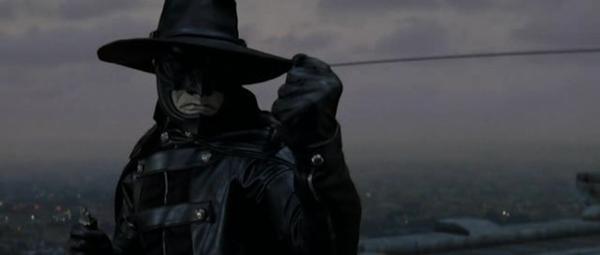K-20: Legend of the Mask
aka K-20: Kaijin niju menso den

2008![]()
Directed by Shimako Sato

In a world where Japan avoided going to war with the US, the Meiji Era nobility continues to exist in 1949. This has created a huge divide between the rich and the poor in the capital city of Teito. Yes, Teito. Stay with me here. No social mobility leads to a massive poor underclass and a tiny fraction of superrich. This playland for the rich is not without costs, as a masked villain known as K-20, the Fiend with 20 Faces, drives fear in their hearts as he steals their money. K-20 is not a noble thief or a Robin Hood, he is just a jerk who robs jerks.
There are also police zeppelins that drop police gyroplanes, because that always happens in comic books.

Series creator Edogawa Rampo is a popular horror and mystery writer whose work has been turned into cinema since 1927. After WWII, most samurai and similar films were banned, and Edogawa Rampo’s vast contemporary work was quickly put on the big screen. The K-20 stories originate in a Boy Detectives series launched in 1936 that lasted 26 years. Edogawa Rampo’s character of The Fiend With Twenty Faces is a mysterious master of disguise, and Detective Kogoro Akechi is called Rampo’s alter ego. Other early Rampo films include 1946’s The Palette Knife Murder (Palette Knife no Satsujin) and 1947’s Ghost Pagoda (Yurei To) and Phantom With Twenty Faces (Kaijin Nijumenso), which is the same Phantom story that inspired the novel this film is based on.

Said novel is the 1989 work from playwright Soh Kitamura, which updates the classic Rampo Akechi tales. Kitamura’s completely new take on the tale caused much controversy among Rampo Edogawa’s fans, much like many remakes.
More about Edogawa Rampo: Yes, Edogawa Rampo is not his real name, Taro Hirai named himself after Edgar Allen Poe! His first writing successes were in 1923, his erotic horror style is called eroguro-nansensu. Other Rampo stories on film include 1969’s The Blind Beast (Moju), 1969’s The Horror of Malformed Men (Kyofu Kikei Ningen), 1976’s The Stroller in the Attic (Yaneura no Sanposha) and 1968’s Black Lizard (Kurotokage). Rampo eventually became a character in mystery films of his own, in the movie Rampo (and this film has two wildly different versions.)

|





